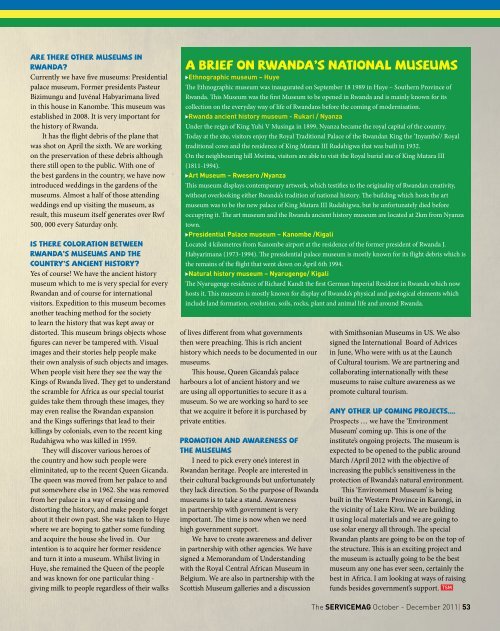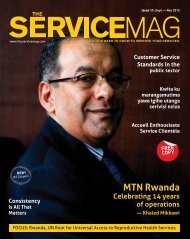Province d - The Service Mag
Province d - The Service Mag
Province d - The Service Mag
You also want an ePaper? Increase the reach of your titles
YUMPU automatically turns print PDFs into web optimized ePapers that Google loves.
Are there other museums in<br />
Rwanda?<br />
Currently we have five museums: Presidential<br />
palace museum, Former presidents Pasteur<br />
Bizimungu and Juvénal Habyarimana lived<br />
in this house in Kanombe. This museum was<br />
established in 2008. It is very important for<br />
the history of Rwanda.<br />
It has the flight debris of the plane that<br />
was shot on April the sixth. We are working<br />
on the preservation of these debris although<br />
there still open to the public. With one of<br />
the best gardens in the country, we have now<br />
introduced weddings in the gardens of the<br />
museums. Almost a half of those attending<br />
weddings end up visiting the museum, as<br />
result, this museum itself generates over Rwf<br />
500, 000 every Saturday only.<br />
Is there coloration between<br />
Rwanda’s museums and the<br />
country’s ancient history?<br />
Yes of course! We have the ancient history<br />
museum which to me is very special for every<br />
Rwandan and of course for international<br />
visitors. Expedition to this museum becomes<br />
another teaching method for the society<br />
to learn the history that was kept away or<br />
distorted. This museum brings objects whose<br />
figures can never be tampered with. Visual<br />
images and their stories help people make<br />
their own analysis of such objects and images.<br />
When people visit here they see the way the<br />
Kings of Rwanda lived. <strong>The</strong>y get to understand<br />
the scramble for Africa as our special tourist<br />
guides take them through these images, they<br />
may even realise the Rwandan expansion<br />
and the Kings sufferings that lead to their<br />
killings by colonials, even to the recent king<br />
Rudahigwa who was killed in 1959.<br />
<strong>The</strong>y will discover various heroes of<br />
the country and how such people were<br />
eliminitated, up to the recent Queen Gicanda.<br />
<strong>The</strong> queen was moved from her palace to and<br />
put somewhere else in 1962. She was removed<br />
from her palace in a way of erasing and<br />
distorting the history, and make people forget<br />
about it their own past. She was taken to Huye<br />
where we are hoping to gather some funding<br />
and acquire the house she lived in. Our<br />
intention is to acquire her former residence<br />
and turn it into a museum. Whilst living in<br />
Huye, she remained the Queen of the people<br />
and was known for one particular thing -<br />
giving milk to people regardless of their walks<br />
A BRIEF ON RWANDA’S NATIONAL MUSEUMS<br />
Ethnographic museum – Huye<br />
<strong>The</strong> Ethnographic museum was inaugurated on September 18 1989 in Huye – Southern <strong>Province</strong> of<br />
Rwanda. This Museum was the first Museum to be opened in Rwanda and is mainly known for its<br />
collection on the everyday way of life of Rwandans before the coming of modernisation.<br />
Rwanda ancient history museum - Rukari / Nyanza<br />
Under the reign of King Yuhi V Musinga in 1899, Nyanza became the royal capital of the country.<br />
Today at the site, visitors enjoy the Royal Traditional Palace of the Rwandan King the ‘Inyambo’/ Royal<br />
traditional cows and the residence of King Mutara III Rudahigwa that was built in 1932.<br />
On the neighbouring hill Mwima, visitors are able to visit the Royal burial site of King Mutara III<br />
(1811-1994).<br />
Art Museum – Rwesero /Nyanza<br />
This museum displays contemporary artwork, which testifies to the originality of Rwandan creativity,<br />
without overlooking either Rwanda’s tradition of national history. <strong>The</strong> building which hosts the art<br />
museum was to be the new palace of King Mutara III Rudahigwa, but he unfortunately died before<br />
occupying it. <strong>The</strong> art museum and the Rwanda ancient history museum are located at 2km from Nyanza<br />
town.<br />
Presidential Palace museum – Kanombe /Kigali<br />
Located 4 kilometres from Kanombe airport at the residence of the former president of Rwanda J.<br />
Habyarimana (1973-1994). <strong>The</strong> presidential palace museum is mostly known for its flight debris which is<br />
the remains of the flight that went down on April 6th 1994.<br />
Natural history museum – Nyarugenge/ Kigali<br />
<strong>The</strong> Nyarugenge residence of Richard Kandt the first German Imperial Resident in Rwanda which now<br />
hosts it. This museum is mostly known for display of Rwanda’s physical and geological elements which<br />
include land formation, evolution, soils, rocks, plant and animal life and around Rwanda.<br />
of lives different from what governments<br />
then were preaching. This is rich ancient<br />
history which needs to be documented in our<br />
museums.<br />
This house, Queen Gicanda’s palace<br />
harbours a lot of ancient history and we<br />
are using all opportunities to secure it as a<br />
museum. So we are working so hard to see<br />
that we acquire it before it is purchased by<br />
private entities.<br />
Promotion and awareness of<br />
the museums<br />
I need to pick every one’s interest in<br />
Rwandan heritage. People are interested in<br />
their cultural backgrounds but unfortunately<br />
they lack direction. So the purpose of Rwanda<br />
museums is to take a stand. Awareness<br />
in partnership with government is very<br />
important. <strong>The</strong> time is now when we need<br />
high government support.<br />
We have to create awareness and deliver<br />
in partnership with other agencies. We have<br />
signed a Memorandum of Understanding<br />
with the Royal Central African Museum in<br />
Belgium. We are also in partnership with the<br />
Scottish Museum galleries and a discussion<br />
with Smithsonian Museums in US. We also<br />
signed the International Board of Advices<br />
in June, Who were with us at the Launch<br />
of Cultural tourism. We are partnering and<br />
collaborating internationally with these<br />
museums to raise culture awareness as we<br />
promote cultural tourism.<br />
Any other up-coming projects….<br />
Prospects … we have the ‘Environment<br />
Museum’ coming up. This is one of the<br />
institute’s ongoing projects. <strong>The</strong> museum is<br />
expected to be opened to the public around<br />
March /April 2012 with the objective of<br />
increasing the public’s sensitiveness in the<br />
protection of Rwanda’s natural environment.<br />
This ‘Environment Museum’ is being<br />
built in the Western <strong>Province</strong> in Karongi, in<br />
the vicinity of Lake Kivu. We are building<br />
it using local materials and we are going to<br />
use solar energy all through. <strong>The</strong> special<br />
Rwandan plants are going to be on the top of<br />
the structure. This is an exciting project and<br />
the museum is actually going to be the best<br />
museum any one has ever seen, certainly the<br />
best in Africa. I am looking at ways of raising<br />
funds besides government’s support. TSM<br />
<strong>The</strong> SERVICEMAG October - December 2011| 53



